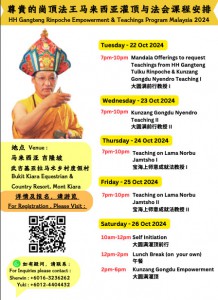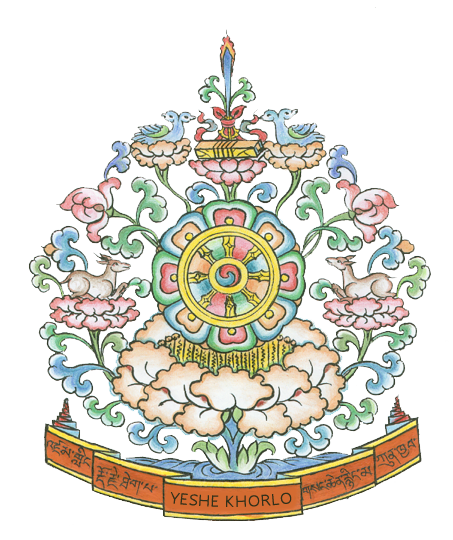 HH Gangteng Tulku Rinpoche will be in Malaysia to give Teachings & Empowerment of Kunzang Gongdu Ngöndro and Lama Norbu Jamtsho from 22 to 27 October 2024.
HH Gangteng Tulku Rinpoche will be in Malaysia to give Teachings & Empowerment of Kunzang Gongdu Ngöndro and Lama Norbu Jamtsho from 22 to 27 October 2024.
It’s a very precious revealed teachings and empowerment, please make time to attend.
Informationen dazu hier:
Dear All,
HH Gangteng Tulku Rinpoche will be in Malaysia to give Teachings & Empowerment of Kunzang Gongdu Nyendro and Lama Norbu Jamtsho from 22 to 27 October 2024.
It’s a very precious revealed teachings and empowerment, please make time to attend.
Please contact Sis Yuki 012 440 4432 or Sis Sherwin 016 323 6262 if you need any clarification or assistance.
See you all soon. Mark the dates to attend !
https://forms.gle/ypcgkCU3CrfM8XXY9
The Biography of His Holiness the Gangteng Tulku Rinpoche by Nora Post.
In 1955, Kunzang Pema Namgyal, the ninth Gangteng Tulku, was born near Tongsa, in a remote, mountainous and stunningly beautiful area of central Bhutan. One day, at the age of three, Kunzang Pema Namgyal was playing alongside the family cows that he had followed into the forest. That day he had taken his father’s locket (Tib. gau) with him, containing a small statue of the Buddha given to his father by the King of Bhutan. He opened the gau and delicately removed the statue. Suddenly the statue rose up, announcing, “I’m going to Gangteng Gonpa!” and flew away. When Kunzang’s father learned that his son had lost the precious statue, he began to spank the boy. But once the child managed to blurt out an explanation, his father stopped in amazement. Sensing the inexplicable, Kunzang’s father at once prostrated to his young son.
The year was 1959, and no one in the family had ever heard the name of Gangteng Gonpa, which was located in the distant hidden land of the Phobjika Valley. Implausibly, the young child had named the winter home of the revered black-necked cranes, as well as the seat of the Gangteng Tulkus, the Body Emanations of the 16th-century King of Tertons (treasure revealer) and patron saint of Bhutan, Pema Lingpa. Subsequently, Kunzang Pema Namgyal was recognized as the ninth successive Body Emanation of Pema Lingpa by His Holiness the l6th Karmapa, Rangjung Rigpe Dorje, by His Holiness Dudjom Jigdral Yeshe Dorje, by His Holiness Dilgo Khyentse, and other masters of Vajrayana Buddhism. He was given the traditional education of an incarnate lama as a monk at Tongsa Monastery before he was formally enthroned at the age of sixteen as the 9th Gangteng Tulku. The enthronement took place at Gangteng Gonpa, the traditional seat of the Gangteng Tulkus. The young abbot then took charge of his legacy– nineteen privately funded Nyingma monasteries and hermitages (since then, this number has expanded to over sixty).
Pema Lingpa himself had chosen the site of Gangteng Gonpa. Construction of the monastery began in the 16th century by Pema Lingpa’s grandson, the first Gangteng Tulku, and was completed later that century by the second Gangteng Tulku. The monastery’s name, attributed to Pema Lingpa, is simple and appropriate: “Top of the Hill.” Gangteng Gonpa is currently the largest privately funded Nyingma monastery in the Kingdom of Bhutan.
The tone of the 9th Gangteng Tulku’s leadership was set immediately when he dispensed with the host of attendants who traditionally had accompanied the Gangteng Tulkus’ every step outside the monastery in long processionals. Still recounted today are his words of advice to his attendants that they needed to look for jobs, because they no longer had any with him.
The 9th Gangteng Tulku then began three years of personal study with His Holiness Dudjom Jigdral Yeshe Dorje Rinpoche, the head of the Nyingma Lineage, receiving the complete set of empowerments and transmissions of the Pema Lingpa lineage from him, as well as from His Holiness Dilgo Khyentse. Both of those masters had received the initiations in Tibet and had brought the texts with them when they escaped from Tibet. Following this period of study, the Gangteng Tulku spent eight years in virtually constant retreat under the tutelage of the former Je Khenpo, Tenzin Dondup. Tenzin Dondup is revered as one of the most highly realized Dzogchen masters of our time; he resides in meditative seclusion in his mountaintop hermitage at the far end of Bhutan’s Thimphu Valley.
Yet, always looming during these periods of spiritual accomplishment were the demands of the historical time period in which the 9th Gangteng Tulku had chosen his rebirth. During the forty-year gap between the present Gangteng Tulku and his predecessor, the 8th Gangteng Tulku (who had spent much of his life as Governor of Paro during the politically turbulent early years of the 20th century), both the Pema Lingpa lineage and the physical structure of Gangteng Tulku’s monasteries had seriously deteriorated. The gravity of the situation was made all the worse by the complete loss of the Pema Lingpa tradition in Tibet. The Tibetan tradition of Pema Lingpa had been firmly established for centuries in the monasteries of Sungtrul and Tukse tulkus (the Speech and Mind Emanations of Pema Lingpa). As the primary holder of the Pema Lingpa lineage, the Gangteng Tulku faced the formidable task of re-establishing those precious practices and teachings. At that time he began a period of intense teaching activity in Bhutan, and also engaged in further years of study in Nepal with revered Dzogchen master His Holiness The Chatral Rinpoche. At the suggestion of his teacher, the former Je Khenpo Tenzin Dondup Rinpoche, the ninth Gangteng Tulku decided in the mid-1980s to visit the West and teach Dzogchen. His aim was both to strengthen the Pema Lingpa lineage by sharing it with Western students, and to gather financial support for the renovation of 400-year-old Gangteng Gonpa–as well as and for the many other Dharma projects he was just beginning in Bhutan. On his first trip he traveled alone, without even a single attendant.
Since completing another three-year retreat in 1992, Gangteng Tulku Rinpoche has been working ceaselessly to assure the survival of both the teachings and practices of the Pema Lingpa tradition. Two three-year retreat centers, a remote Dzogchen hermitage for three-year retreat, the new monastery (Ogyen Ling) near his birth region in Tongsa, a nunnery and shedra for women near Pema Lingpa’s birthplace in Bumthang, and a highly-acclaimed university-level shedra adjacent to Gangteng Gonpa are but a few of the results of the Gangteng Tulku’s impressive efforts to re-establish the Pema Lingpa lineage in Bhutan and to introduce it to many other parts of the world. Rinpoche has traveled and taught in both Europe and North America each year, and has established centers in Austria, Canada, France, Germany, Poland, Russia, Switzerland, Slovenia and the United States.
His retreat centers in the West include Pema Yang Dzong in France and Choying Dzong in Colorado.
This biography of Gangteng Tulku Rinpoche is written by Nora Post working with several lamas including Gangteng Tulku Rinpoche’s brother, Khenpo Rabgay.
This is an Overview of the Practice According to Pema Lingpa’s Great Perfection.
The preparatory practices (ngöndro) of the Samantabhadra Mind Essence ritual, also known as the five preliminaries, are considered the main practices despite being called preliminaries. This is because the cutting-through (trekchö), direct crossing (tögal), and bardo teachings of the Great Perfection are based on these practices, and they cannot be replaced by the preliminary practices from other lineages. Pema Lingpa is the fourth of the five Tertön Kings prophesied by Guru Rinpoche, and he is also the reincarnation of the 14th-century master Longchenpa and the fifth reincarnation of Princess Pemasal, the daughter of King Trisong Detsen. Guru Rinpoche predicted that Pema Lingpa would discover 108 volumes of hidden treasures (terma), of which he revealed 32. The five preliminaries are divided into “common” and “uncommon” practices. *Common Practices* refer to the Four Thoughts that Turn the Mind, including the preciousness of human rebirth, the impermanence of life, the law of karma, and the defects of samsara. These practices cultivate renunciation and the aspiration to follow the true path.
*Uncommon Practices* include five:
1. *Taking Refuge*: This specifically refers to taking refuge in the Pema Lingpa lineage, which is the foundational cornerstone of all Buddhist practices.
2. *Generating Bodhicitta*: This is the altruistic intention to attain Buddhahood for the benefit of all sentient beings, combining compassion and wisdom.
3. *Purification of Negativities*: This involves the recitation of the Hundred Syllable Mantra and the Vajrasattva mantra along with visualization practices to purify all obstacles and negative karma.
4. *Accumulation of Merit*: This is practiced through the offering of mandalas, either in sets of 37, 5, or 7 heaps, to accumulate the merit and wisdom needed for spiritual progress.
5. *Guru Yoga*: Faith is the mother of all virtues on the path, and the guru embodies the Buddha, Dharma, and Sangha. Cultivating firm faith in the guru strengthens one’s path towards Buddhahood and invokes the blessings and protection of the lineage masters and all Buddhas and Bodhisattvas. This is also the key essence of the profound path basis on the Vajrayana.
### Requirements for Retreat Participation To qualify for the four-year retreat on the Samantabhadra Mind Essence teachings, one must complete 10,000 repetitions of each of the five preliminary practices.
Lama Norbu Gyatsho
It is revealed teaching of Terton Pema Lingpa on Guru Rinpoche.
It’s called Guru Cycle as it pertains to invocation of Guru Rinpoche.
The name of this c
ycle is called Lama Norbu Gyatsho literally meaning the Guru Jewel Ocean.
https://www.facebook.com/share/v/vRSrK9c8JYfdHxEF/?mibextid=xfxF2i



